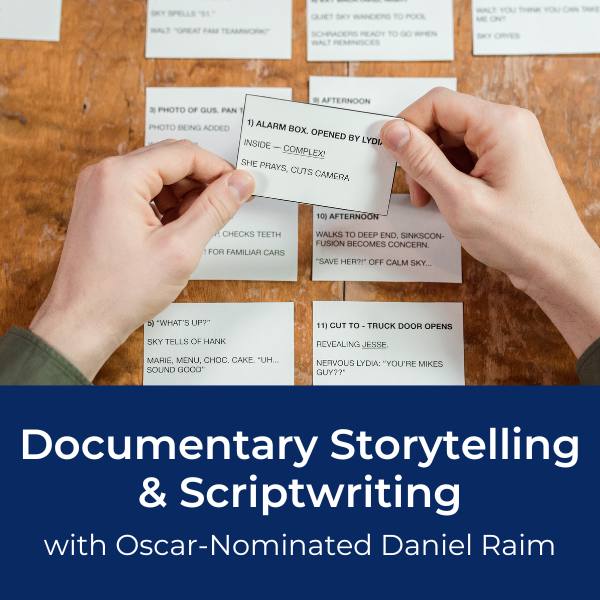12-Point Check List for Aspiring Documentary Filmmakers

Guest Post By: Daniel Raim, Adama Films
Hello fellow filmmakers! Are you ready to start making a documentary and not quite sure what to do first or what to do next?
In my 20+ years making documentaries I have learned and developed a few methods that have helped move my projects forward and break the ice in my creative process. I am sharing these ideas below in the hope that they help you in your own filmmaking journey.
"A movie is like a tip of an iceberg because so little of what you do in connection with making a movie actually gets into the movie. Almost everything gets left behind."
~Errol Morris
12-Point Filmmaking Check List
1. Pick your topic carefully
If you’re planning on making a feature-length documentary, give thought to the level of commitment involved before internally greenlighting the film. Does your story have the substance and thematic weight to sustain a feature-length documentary? Are you prepared to spend the next two to five years of your life making and releasing this film?
2. Begin with the core idea and feeling
This is the underlying theme that inspires you to make the film. It will eventually keep your audience engaged as they go on an exploration of that theme and story with you. Write a few pages in your journal about the topic of your film and what themes resonate or don’t resonate with you.
3. Develop a distribution and marketing plan
Where do you see your film screening? At a film festival? On HBO or Netflix? A grassroots screening tour on college campuses? What’s the best fit for your film? How will you approach the story to engage with that specific audience?
Learn Documentary Distribution
4. Develop your pitch (ASAP)
When you bump into a decision-maker or distributor at a film festival, or inside an elevator, can you encapsulate your story in one or two sentences that will leave them wanting more? It is worth having your "Elevator Pitch" prepared, especially when you cross paths with prospective producers and decision-makers. Develop your pitch to encompass who or what your film is about, what they want (goals, needs and desires), and what is standing in their way of getting it (obstacles and conflicts). Highlight your “hook,” or what makes your take on this topic unique.
5.Research and note-taking
Research is a vital part of the documentary writing process. Start by poring over a couple of books on the subject you’re interested in pursuing and make detailed notes. What engages you? What stands out?
6. Think visually and remember audience reactions
In 1948, Alexandre Astruc formulated the concept of the caméra-stylo (“camera-pen”).
You are making a work of cinematic art and that includes ‘writing with the camera.’ Consider how playing with framing and certain styles of shooting and lighting your subjects can influence what the audience feels and perceives about the story and characters.
Learn Documentary Storytelling
7. Choose the right length
Be honest with yourself: can your story sustain audience engagement for a feature doc, or is the story best presented as a short subject? Track down Oscar-Nominated Short Subjects and mini-documentaries on Vimeo to get a feeling for the format.
8. Get the ball rolling
Call your subject and book the interview! Make a shot list and a list of questions. Hire a cameraperson, a sound technician, and prep for the interview! Then review your footage and see what you have. Is it ripe with potential? Are your characters engaging to watch on-screen?
9. Dramatize your story through editing
Your job is to keep the audience engaged. Study dramatic structure and shape your story, themes, and character’s journey into a dramatic and cinematic form. Keep in mind both the internal and external struggle of your protagonists. What’s stopping them from getting what they want?
10. Refine your themes
Analyze your structure in its current form.
How do your character's internal and external obstacles intersect with the themes of your narrative? Does each scene, sequence, and act escalate in emotion and develop the central thematic question?
11. Study the masters
Overcome Resistance! What films and filmmakers inspire you?
When you get stuck on structure, go back to your favorite movie and break it down for inspiration.
12. Listen to your gut
Documentary storytelling is not about following a set of rules or copying another filmmaker’s style and approach. The success of your storytelling rests upon you listening to your heart and intuition, while drawing from your ability to use effective storytelling techniques.
About The Author

Academy Award®-Nominated Writer-Director Daniel Raim has made a career directing documentaries dedicated to the art and craft of filmmaking.
He has directed numerous award-winning and critically acclaimed feature documentaries and documentary short subjects.
Four of those films received impressive theatrical releases, including HAROLD AND LILLIAN: A HOLLYWOOD LOVE STORY (2015, Official Selection Cannes Film Festival + Turner Classic Movies broadcast premiere + Netflix 2018 release) and IMAGE MAKERS: THE ADVENTURES OF AMERICA'S PIONEER CINEMATOGRAPHERS (2019 TCM).
In Spring of 2022, Daniel's brand new Jeff Goldblum-narrated documentary feature, FIDDLER'S JOURNEY TO THE BIG SCREEN, had its theatrical release through Zeitgeist Films in association with Kino Lorber.
Through Daniel's films and his teaching, he has inspired future generations of storytellers and visual artists around the world.
Daniel is the instructor for the popular Documentary Storytelling & Scriptwriting Course offered exclusively here on Desktop Documentaries.
Documentary Resources
Other Articles You May Enjoy
- How To Survive The Making Of A Documentary
- How To Organize 60 Years Of History Into A 94-Minute Documentary
- How To Get Your Documentary On Netflix



















